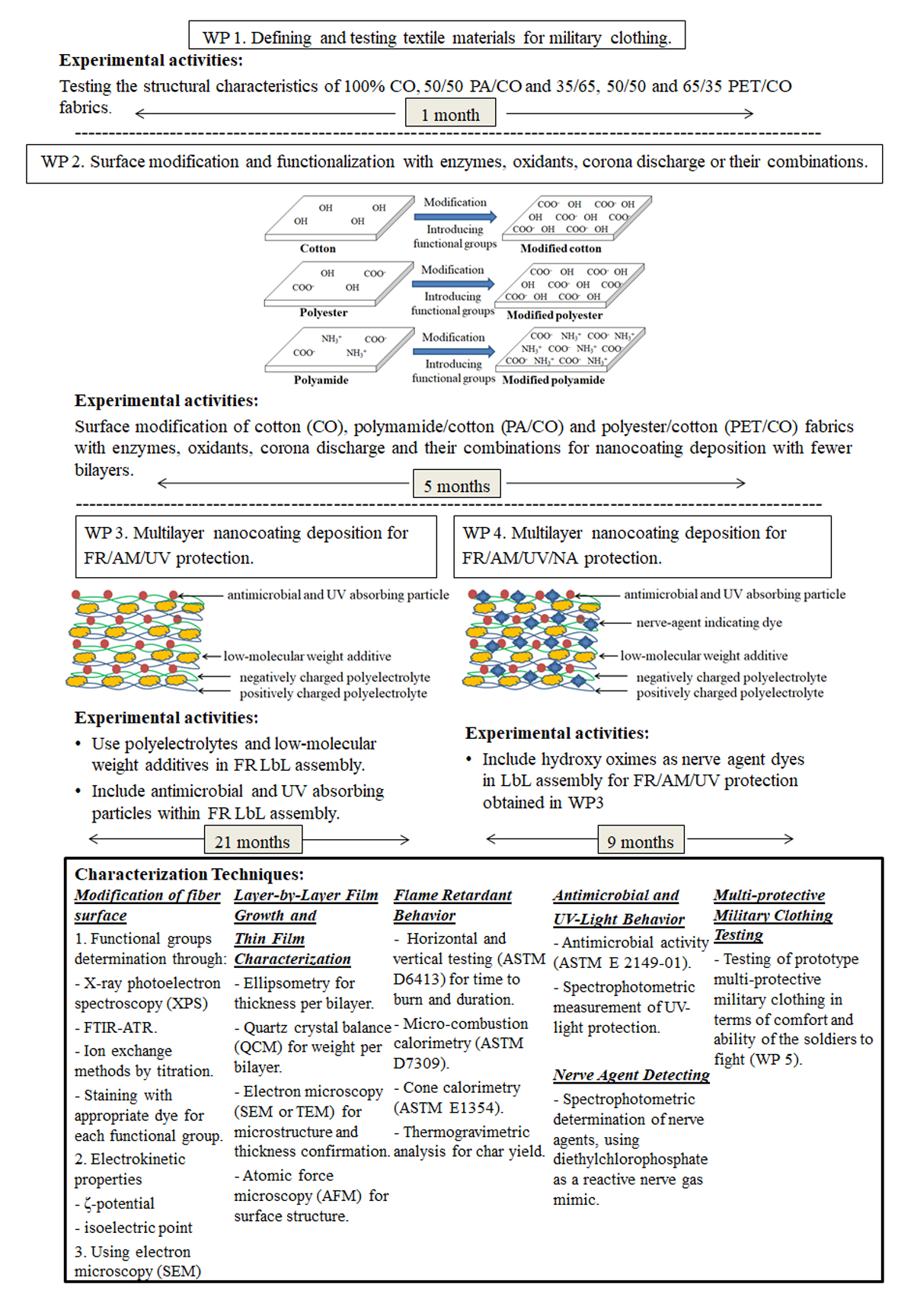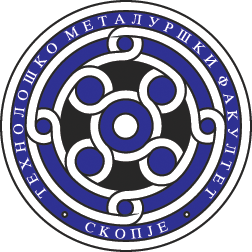The MULProTex project aims to develop multi-protective military clothing for fire, micro-organisms organophos – phorus-containing nerve agents, and UV-light protection through the application of non-toxic and renewable multi – layer nanocoatings and indicating dyes using layer-by-layer assembly deposition. The multi-functionality of military clothing has always been a major research topic amongst military, academic and industrial textile specialists. Most clothing today combines one or two properties achieved by traditional non-energy efficient finishing processes that produce uncomfortable textiles containing chemicals that are toxic for humans. The consequent need to find low cost, non-toxic and simply applicable textile treatment that can provide multifunctional properties is heightened due to increasingly rigorous environmental protection rules. This project will use water-based multilayer nanocoatings composed of non-toxic, eco-friendly, and renewable poly – electrolytes together with low molecular weight additives, nanoparticles, and nerve agent indicating dyes. This layer-by-layer assembly is a simple, inexpensive, environmentally-benign and highly tailorable water-based technique, performed by alternate exposure of a substrate to oppositely-charged polyelectrolyte solutions or suspensions at room temperature, giving rise to a multilayer thin nano-film. It is one of the most promising techniques for textile finishing that could be easily employed using traditional pad-dry processing widely used in the industry. It also allows the design of an unlimited combination of assemblies with impressive multi-functionality. Thin nanocoatings created with this technique arep romising for applications requiring comfort and the desired mechanical properties of the textile substrates.
OBJECTIVES
- Definition and test of the most used textile fabrics for military clothing, in terms of their fibre composition and fabric construction;
- Exploration of proper treatment with enzymes, oxidants, atmospheric corona discharge (or their combinations) for optimal surface modification and functionalization of textile fabrics, making them more amenable for nanocoating deposition, while avoiding fibre degradation;
- Definition and development of multi-protective textile fabrics for fire, antimicrobial, UV-light and nerve agents protection using multilayer nanocoatings composed of polyelectrolytes, low-molecular weight additives, nanoparticles, and nerve agent indicating dyes;
- Production and test of a prototype of multi-protective military clothing based on the project results.
Visual timeline of MULPROTEX

OUTCOMES
MULProTex will enhance the protection of personnel and soldiers against nerve agents, microorganisms, fire and radiation. Through this project, the Faculty of Technology and Metallurgy in Skopje will benefit from the establishment of a laboratory for advanced materials. This project will contribute to the protection of the environment through the implementation of a circular economic concept that stimulates the use of renewable chemicals. Creating multi-protective textile materials by implementing a circular economy concept using non-toxic and renewable polyelectrolytes from waste is a new ”green” concept in textile finishing that will change the face of military clothing production. Furthermore, MULProTex will advance multi-protective nanocoating technologies that are understudied despite being a matter of great scientific concern. Developing such products will widen and scale-up possible applications, and open up new perspectives for using the layer-by-layer deposition technique to produce nanocoatings suitable for other applications.
PARTICIPATING INSTITUTIONS
Texas A&M University, College of Engineering
Texas A&M University, founded in 1876, is a public, comprehensive university. It is one of the few institutions holding triple federal designations as a land-, sea- and space-grant university in the United States. The University’s College of Engineering is one of the largest engineering schools in the country. Its researchers have established pre-eminence in the research areas of autonomy and robotics; energy systems and services; education and training; health care; information systems and sensors; materials and manufacturing; national security and safety; and infrastructure. Underlying technologies that propelled the college to the forefront of the above research areas include mathematical modelling and simulation, optimization, mechanics, sensors, structures, robotics, autonomous vehicles, communications and networks, process engineering, materials, and computational sciences.
University of Belgrade, Faculty of Technology and Metallurgy
The Textile Engineering Department of the University of Belgrade has a long tradition of offering prominent multiplicity of scientific, technical and specific educational activities. Its studies on textile fibers include the analysis of fiber structure and structure-properties relationship. Modification of the fiber structure and surface for the application in composite materials, ion exchange systems and biologically active materials are also examined. Recent research is mainly focused on the application of advanced methods for modification of textile materials based on natural and synthetic fibers in order to enhance their functionality. RF low-temperature plasma and corona treatments, enzymatic and biopolymer chitosan treatments are used as potentially environmentally friendly methods for imparting specific functional properties to textile materials necessary for design and production of high added value textile products.
Ss. Cyril and Methodius University in Skopje, Faculty of Technology and Metallurgy
The Faculty of Technology and Metallurgy in Skopje is a leading and eminent higher education institution in North Macedonia. Founded in 1959, the Faculty has remarkably contributed to the development of the Macedonian economy, primarily through the education of highly qualified engineers and staff, following all modern market trends and scientific developments. Within the Faculty, the Textile Department, with its 50 years tradition in education, research and industrial collaboration, is one of the most prominent and recognized educational institution among the textile industry in North Macedonia. The textile department is divided into textile chemistry, mechanical textile technology and garment production. Today, the main mission of the Faculty is to ensure the continuous development of its appropriate human resources by offering recognized and high-quality studies and research programs. It will allow the faculty to keep its high reputation in the field, and to maintain and build relationships with similar scientific institutions and companies worldwide.
DOCUMENTS
EVENTS
Kick-off
NATO-SPS PROGRAM
The Science for Peace and Security (SPS) Programme promotes dialogue and practical cooperation between NATO member states and partner countries based on scientific research, technological innovation and knowledge exchange. The SPS Programme offers funding, expert advice and support to tailor-made, civil security-relevant activities that respond to NATO’s strategic objectives.
- The SPS Programme enhances practical, result-oriented cooperation involving scientists, experts and government officials from NATO member and partner countries alike.
- It responds and adapts to the changing security environment to support NATO’s strategic objectives and political priorities in its relations with partner countries.
- The SPS Programme makes contributions to NATO’s efforts to project stability and build capacity in partner countries.
- SPS activities are guided by security-related priorities such as counter-terrorism, cyber defence, advanced technologies, energy and environmental security, and threats posed by chemical, biological, radiological, nuclear and explosive (CBRNE) hazards.
- Over the past five years, the Programme has initiated more than 450 collaborative activities among its member states and partner countries
CONTACT US

Texas A&M University, College of Engineering
Professor Jaime C. Grunlan
Address:
Telephone:
Email:

University of Belgrade, Faculty of Technology and Metallurgy
Professor Maja Radetic
Address:
Telephone:
Email:

Ss. Cyril and Methodius University in Skopje,
Faculty of Technology and Metallurgy
Professor Igor Jordanov
Address:
Telephone:
Email:
